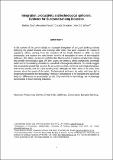Integration, productivity and technological spillovers : evidence for eurozone banking industries
Abstract
In the context of the current debate on increased integration of eurozone banking markets following the global financial and sovereign debt crises, this paper evaluates the impact of regulatory reform, starting from the inception of the Single Market in 1992, on bank productivity and assesses the cross-border benefits of integration in terms of technological spillovers. We utilise a parametric meta-frontier Divisia index to estimate productivity change and identify technological gaps. We then assess the extent to which productivity converges within and across banking industries as a result of technological spillovers. Our results suggest that productivity growth has occurred for eurozone countries, driven by technological progress, both at the country and the supra-country level, although the latter slows or in some cases reverses since the onset of the crisis. Technological spillovers do exist, and have led to progression toward the best technology. However, convergence is not complete and significant long run differences in productivity persist. Improvements in technology are increasingly concentrated in fewer banking industries.
Citation
Casu , B , Ferrari , A , Girardone , C & Wilson , J O S 2016 , ' Integration, productivity and technological spillovers : evidence for eurozone banking industries ' , European Journal of Operational Research , vol. 255 , no. 3 , pp. 971-983 . https://doi.org/10.1016/j.ejor.2016.06.007
Publication
European Journal of Operational Research
Status
Peer reviewed
ISSN
0377-2217Type
Journal article
Collections
Items in the St Andrews Research Repository are protected by copyright, with all rights reserved, unless otherwise indicated.

